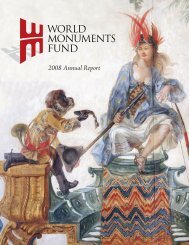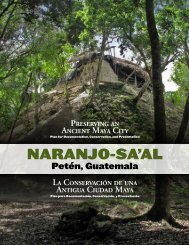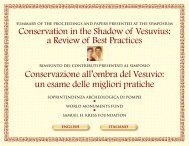Lodi Garden and the Golf Club (pdf) - World Monuments Fund
Lodi Garden and the Golf Club (pdf) - World Monuments Fund
Lodi Garden and the Golf Club (pdf) - World Monuments Fund
You also want an ePaper? Increase the reach of your titles
YUMPU automatically turns print PDFs into web optimized ePapers that Google loves.
© The British Library Board. [Photo 1003/(896)]<br />
called Lady Willingdon Park, after <strong>the</strong> wife of <strong>the</strong> <strong>the</strong>n British Viceroy.<br />
Post-Independence, it was more appropriately renamed <strong>Lodi</strong> <strong>Garden</strong><br />
<strong>and</strong> was redesigned in 1968 by J.A. Stein, an eminent architect, who<br />
was also involved with many o<strong>the</strong>r buildings around <strong>the</strong> <strong>Lodi</strong> <strong>Garden</strong><br />
complex. The oldest structure in <strong>the</strong> <strong>Lodi</strong> <strong>Garden</strong> complex is a turret(an<br />
Archaeological Survey of India [ASI] protected structure) that appears<br />
to have been part of a walled enclosure (not evident any more) which<br />
historians believe to have belonged to <strong>the</strong> Tughlaq period(ad 1320–<br />
1413). Nothing else is known about <strong>the</strong> o<strong>the</strong>r structures here that<br />
were also built at this time.<br />
Most of <strong>the</strong> tombs <strong>and</strong> mosques go back to <strong>the</strong> time of <strong>the</strong> Sayyid<br />
<strong>and</strong> <strong>Lodi</strong> rulers of Delhi when <strong>the</strong> area was called Bagh i-Jud, in <strong>the</strong><br />
fifteenth <strong>and</strong> early sixteenth centuries. The Sayyids established <strong>the</strong>ir<br />
small sultanate in <strong>the</strong> fifteenth century (ad 1414–51) with Khizr<br />
Khan as <strong>the</strong> first ruler, who ruled Delhi for seven years by gaining<br />
power from <strong>the</strong> Timurids. Khizr Khan was succeeded by his son<br />
Mubarak Shah who ruled for more than a decade after his fa<strong>the</strong>r’s<br />
death in 1421. The third ruler Muhammed Shah, reigned subsequently<br />
from ad 1434–44. His son Alauddin Alam Shah is known to have<br />
built Muhammed Shah’s Tomb, <strong>the</strong> oldest <strong>and</strong> <strong>the</strong> solitary testimony to<br />
<strong>the</strong> Sayyid Dynasty in <strong>the</strong> garden, now an ASI protected site.<br />
The Sayyid dynasty was displaced by <strong>the</strong> <strong>Lodi</strong> Dynasty<br />
(ad 451–1526) which originated from an Afghan tribe that had been<br />
in India for a long time. Bahol, <strong>the</strong> first <strong>Lodi</strong> king, seized power from<br />
<strong>the</strong> Sayyids without much resistance <strong>and</strong> re-established <strong>the</strong> prowess of

















